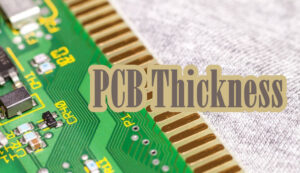PCB Thickness
2022-09-14When we talk about the size of PCB manufacturing, the size of the standard provisions is essential. Although there is no specific standard for PCB thickness, but to maximize the convenience of PCB manufacturers to fabricate these PCBs, some dimensional standards have been used. For different needs of the PCB project, designers will design different PCB thickness. In this article, we will discuss how to determine the thickness of the PCB and some important factors affecting the thickness of the PCB.
What is the standard PCB thickness?
KingPCB commonly used board thickness is generally 1.6mm +/-10%, which is the most common PCB thickness in PCB manufacturing. Of course, there are other board thicknesses such as 0.8mm, 1.8mm, 2.0mm, etc.
To meet the needs of more robust or multilayer boards, the board may also have other thicknesses.
It is important to know the industry standard thickness, unconventional board thickness may require customization. The main factors that affect PCB thickness are design factors and manufacturing factors. We will detail these factors below and help you determine how to select PCB thickness for your project.
Design factors affecting the thickness of the PCB
- Size, weight and flexibility
For different needs, thinner boards are more flexible, but more likely to break due to brittleness. Thicker circuit boards are more robust, but they also take up more space within the device.
- Choice of board material
PCB operation and service life depends on the choice of materials, but these choices can also affect the thickness of the board. Circuit board manufacturing includes substrates, laminates, solder resist layers and screen printing. Substrates and laminates are the most important points to consider, as they greatly influence the overall thickness in construction.
- Copper thickness
Standard copper thickness in 1.4 ~ 2.8 mil, copper thickness depends on the need to pass the PCB current size, the thicker the copper, the thicker the board, the higher the cost.
- PCB layers
For 2 to 6 layers of PCB thickness may be within the standard board thickness, but for more than 6 layers of multi-layer PCB may require a greater thickness.
- Signal type
PCBs can carry a variety of signal types, high-powered signal boards require thicker copper and wider alignments, which means it will lead to an increase in board thickness. However, high-density boards with more complex signals often use laser micro via technology, finer alignments and high-performance materials, and they are usually thinner than other board types.
- Operating environment
The thickness of the board and the materials it consists of affect the conductivity and resistance of the PCB, so different thicknesses are required in different environments.
- Through-hole type
PCB through-hole through the board, which is important to create a more compact design. Many different through-hole types can be used.
Through-hole
Micro vias
Grounded
Solder pad vias
Manufacturing factors affecting PCB thickness
- Drilling equipment
When drilling any type of hole, manufacturers are limited by the thickness of the board and the diameter and depth capabilities of the milling machine and laser. For thicker boards, this means that manufacturers are less able to achieve small diameter holes.
- Copper thickness
Copper traces are completed by etching. The manufacturing process of etching or plating depends on the thickness of the internal copper layer.
- Layers counts
As mentioned earlier, the more layers on the PCB, the more difficult it is to manufacture to a standard thickness.
- Depanelization method
Manufacturers produce PCBs in large panels containing multiple boards, and then divide the panel into individual boards. The thickness of the circuit board affects the depaneling method that can be used-thicker boards may require careful depaneling using scores, while thinner boards may be routed to create separation labels.
Factors to consider when selecting PCB thickness
- Equipment capacity
When choosing PCB thickness, the first thing you should consider is whether your PCB manufacturer has the equipment to meet your specific needs, and of course, any more advanced technology will add a corresponding cost.
- Delivery time
For board thicknesses that require special customization may require the manufacturer to change the setup as well as the manufacturing process. The more difficult the requirement the further additional turnaround time will be added.
- Additional Costs
You should carefully communicate with your PCB manufacturer to assess the feasibility of your PCB project. Customization of PCBs with different parameters than the norm may result in different costs.
Contact KingPCB
Choose to work with a PCB manufacturer that can meet your needs and provide professional advice. KingPCB, a leading PCB supplier in Shenzhen, China with over 10 years of PCB and assembly experience. To learn more about KingPCB's manufacturing capabilities, contact us today and feel free to ask any questions.




